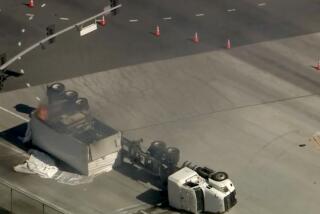Plan Aims to Reduce Freeway Truck Traffic
In an attempt to cut rush-hour truck traffic on the Harbor Freeway during an extensive widening and busway construction project, the Los Angeles City Council on Tuesday approved a plan to expand delivery hours for businesses near the freeway.
The move encourages businesses and trucking companies to make shipments outside rush hours. It is part of a voluntary truck rescheduling plan intended to ease congestion during the $548-million project, which got under way several months ago and is expected to continue for four years.
According to Caltrans, more than 230,000 vehicles a day use the Harbor Freeway, one of the most traveled in Los Angeles. The Harbor has an accident rate 50% higher than the average Los Angeles freeway, and motorists on it are delayed in traffic 40% longer than average.
After surveying traffic this week, Caltrans estimated that 6% of the vehicles on the Harbor Freeway are trucks, though no breakdown by time of day was available. While the percentage may seem low, officials said, it is important to get trucks off the freeway during rush hours because they cause so much disruption when involved in accidents.
“Every little bit helps,” said Dave Kilmurray, Caltrans chief of design for the project. “Our goal is to get people to avoid areas that are under construction.”
Outright Ban Rejected
City officials said they had considered imposing a mandatory ban on rush-hour truck traffic, which would have required approval from the Federal Highway Administration because the Harbor Freeway is an interstate highway. They rejected the idea, however, because it would involve too much red tape and would probably divert trucks onto city streets.
The voluntary program, expected to begin in June, is modeled after one on the Ventura Freeway in the San Fernando Valley, where peak-hour truck traffic has been reduced by 15%. The program attempts to cut truck traffic between 6:30 and 9 a.m. and between 3 and 6 p.m., the most congested periods of the day.
Under the program, businesses in an area bounded by Western Avenue, the Santa Monica Freeway, Central Avenue and the San Diego Freeway can apply for special permits to accept deliveries as early as 6 a.m. and as late as 11 p.m. Normally, deliveries are allowed only between 7 a.m. and 10 p.m.
The program requires businesses with special permits to comply with city noise regulations, leading city officials to conclude that only so-called “low-noise businesses”--those not involved in heavy manufacturing, for example--would qualify for the extended hours. In the San Fernando Valley, nine special permits have been granted, and “nobody has complained about the noise,” said James Okazaki, who oversees development of the Harbor Freeway “transitway” for the city.
In addition to the voluntary truck reduction, the city and Caltrans have developed a plan to divert traffic to surface streets downtown when construction closes ramps or the freeway itself. Caltrans, for example, is expected to temporarily close ramps today at Vernon Avenue and 51st Street.
The 19.6-mile construction project extends from Channel Street in San Pedro to the Santa Monica Freeway near downtown Los Angeles. It involves widening several segments of the freeway from six to eight lanes south of Artesia Boulevard and building a 10.3-mile commuter and bus transitway down the center of the freeway between the Artesia and Santa Monica freeways.
The transitway, designed for buses and car pools, will be able to accommodate a light-rail line in the future. Most of the transitway will be built at the freeway level, but two sections of it near downtown, totaling more than two miles, will be elevated.
Transfer Station
Plans call for nine bus stops along the freeway, including park-and-ride facilities at Channel Street in San Pedro, Pacific Coast Highway in Wilmington, Carson Street in Carson and Rosecrans Avenue in the Harbor Gateway. It also includes a bus and light-rail transfer station at the Century Freeway interchange and an elevated ramp connecting the transitway to a bus station and park-and-ride lot at the Artesia Freeway interchange.
Although work on segments of the project began several months ago, Kilmurray of Caltrans said the most noticeable work will not begin until summer. Construction on the elevated ramp at the Artesia Freeway interchange--probably the most visible portion of the project in the South Bay--may not begin until early next year, he said.
Even so, Kilmurray said, motorists who commute on the freeway are advised to begin now to car pool, find alternative routes to work, use public transportation or alter work hours.
“It never hurts to start early,” he said.
More to Read
Sign up for Essential California
The most important California stories and recommendations in your inbox every morning.
You may occasionally receive promotional content from the Los Angeles Times.










